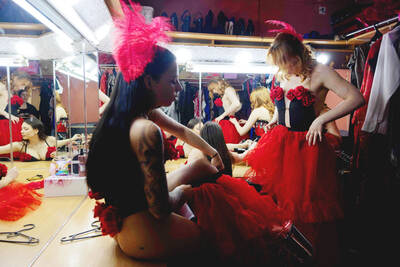It’s a dog’s life during hard economic times. But Chihuahuas in a tutu? Pugs in designer tank-tops? Dachshunds draped in Swarovski bling?
That was the scene at the third annual Pet Fashion Week in Manhattan this past weekend, where despite a looming US recession, the world’s dog-loving fashionistas gathered to share ideas, market their products, strut a canine catwalk and raise money for charity.
At a time when department stores are suffering from shrinking sales of clothing, shoes and accessories such as handbags, those in the pet fashion industry are thriving, thanks to dog-loving elites and the buying impulses of millions of other pet owners.
“I’ve always loved dressing up dolls and Barbies, and I wanted to take it into something else that I loved, and I love pets,” pet-fashion designer Kameron Westcott from Dallas, Texas said as her five-year-old Yorkshire terrier, Louis, peeked out of a canine carry bag designed by luxury fashion giant Louis Vuitton.
“Dogs need to be cute when they go to parties as well,” quipped Westcott, who runs an Internet web site hawking a range of Brazilian-made clothes and accessories for dogs.
“They want to feel elite and posh, just like we are.”
These dogs are having their day. All five floors of an exhibition center in southern Manhattan were crammed with dozens of stands marketing a range of pet beauty products and clothes.
Palacial doghouses on offer stood covered in lush drapes and filled with cushions bearing Swarovski jewels (price: US$9,000 to US$15,000) and other jewelry, while other vendors were peddling the “must-haves” of the moment: all things environmentally friendly and recyclable.
Such green items ranged from cardigans knitted out of Andean alpaca wool to a line of bamboo-only products by “Pet Duti,” a brand which offers items aimed at easing the unfashionable modern-day necessity of cleaning up after one’s dog outside.
Pet Fashion Week proved to be a runaway success, although one woman was disappointed. “You can’t stop me, I want my money back,” shrieked a lady on the verge of a meltdown after having been barred from one of the events Saturday morning for having the wrong ticket.
“No, you paid for the evening charity show. This one is for buyers, designers and the media,” a hostess responded, unruffled.
The show’s stars came out amid an elaborate and ominous backdrop of oil drums and abandoned jerricans meant to evoke the “scary situation” reflected by today’s energy crisis, according to organizers.
Bulldogs paraded out wearing tight wool knits, and elegant Afghans sauntered by clad in Hermes, all led by human fashion models as sumptuously outfitted as their four-legged friends.
Chihuahuas skittered about in tutus, and a trio of tank-top-wearing pugs were pushed down the makeshift catwalk in a shopping cart.
Swedish designer Tania Fylking, seeking a new outlet for her flair for fashion, made the trip to New York at the suggestion of a friend.
“I flew from Stockholm and I do not regret, I hope to find an agent for my brand,” said Fylking, who specializes in producing exotic leather goods favored by several Hollywood celebrities for their pets.
According to the American Pet Products Manufacturers Association, 63 percent of US homes — some 71 million households — have pets. They include 88 million cats, 75 million dogs, 142 million goldfish and 13 million reptiles.
Spending on pets rose in 2007 to US$40 billion, compared with US$28.5 billion in 2001, including US$17 billion spent on food, US$11 billion on veterinary care, US$10 billion dollars on medicines and US$3.9 billion on pet toys, clothing and “dog-sitters.”
On its Web site, the association says doctors claim that “pets help to lower blood pressure, to reduce stress, to prevent heart disease, to lower healthcare costs, to fight depression and loneliness.”

The canonical shot of an East Asian city is a night skyline studded with towering apartment and office buildings, bright with neon and plastic signage, a landscape of energy and modernity. Another classic image is the same city seen from above, in which identical apartment towers march across the city, spilling out over nearby geography, like stylized soldiers colonizing new territory in a board game. Densely populated dynamic conurbations of money, technological innovation and convenience, it is hard to see the cities of East Asia as what they truly are: necropolises. Why is this? The East Asian development model, with

June 16 to June 22 The following flyer appeared on the streets of Hsinchu on June 12, 1895: “Taipei has already fallen to the Japanese barbarians, who have brought great misery to our land and people. We heard that the Japanese occupiers will tax our gardens, our houses, our bodies, and even our chickens, dogs, cows and pigs. They wear their hair wild, carve their teeth, tattoo their foreheads, wear strange clothes and speak a strange language. How can we be ruled by such people?” Posted by civilian militia leader Wu Tang-hsing (吳湯興), it was a call to arms to retake

This is a deeply unsettling period in Taiwan. Uncertainties are everywhere while everyone waits for a small army of other shoes to drop on nearly every front. During challenging times, interesting political changes can happen, yet all three major political parties are beset with scandals, strife and self-inflicted wounds. As the ruling party, the Democratic Progressive Party (DPP) is held accountable for not only the challenges to the party, but also the nation. Taiwan is geopolitically and economically under threat. Domestically, the administration is under siege by the opposition-controlled legislature and growing discontent with what opponents characterize as arrogant, autocratic

When Lisa, 20, laces into her ultra-high heels for her shift at a strip club in Ukraine’s Kharkiv, she knows that aside from dancing, she will have to comfort traumatized soldiers. Since Russia’s 2022 invasion, exhausted troops are the main clientele of the Flash Dancers club in the center of the northeastern city, just 20 kilometers from Russian forces. For some customers, it provides an “escape” from the war, said Valerya Zavatska — a 25-year-old law graduate who runs the club with her mother, an ex-dancer. But many are not there just for the show. They “want to talk about what hurts,” she